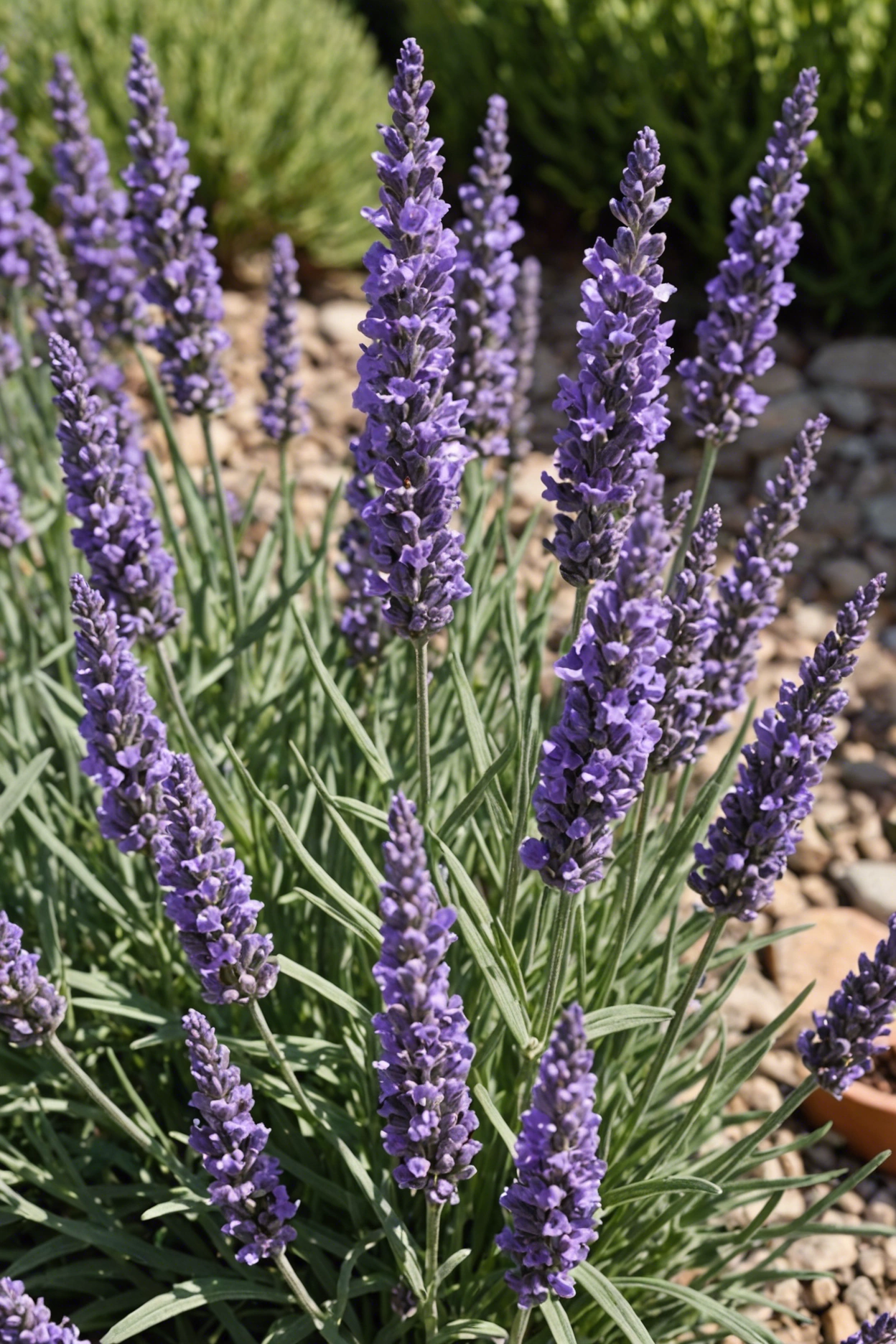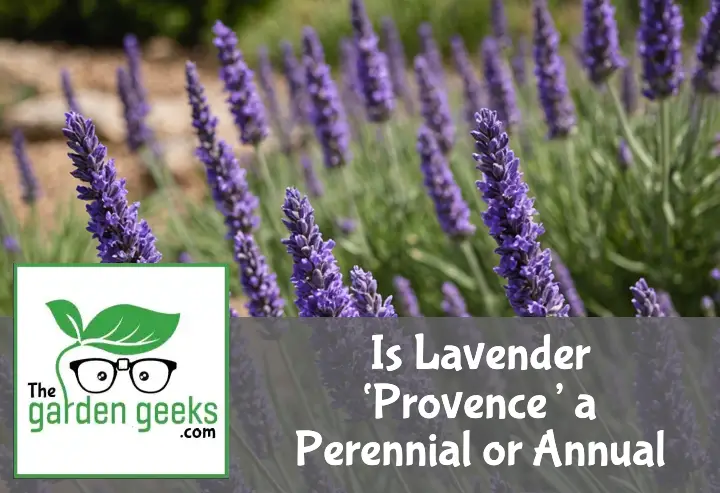Did you know that there are more than 450 varieties of lavender in the world? Among these, one stands out for its distinctive aroma and striking beauty – Lavender ‘Provence’. The question that often arises among gardening enthusiasts and plant lovers is: Is Lavender ‘Provence’ a Perennial or Annual?
Lavender ‘Provence’, also known as Lavandula x intermedia ‘Provence’, is a popular choice for gardens due to its vibrant purple flowers and soothing fragrance. But whether it’s a perennial or annual can greatly impact how you care for it.
So, if you’ve been wondering about this particular variety of lavender, stick around. In this article, we’ll delve into the details to help you understand its nature better. Keep reading about Is Lavender ‘Provence’ a Perennial or Annual.
Quick Answer
- Lavender ‘Provence’ is a perennial plant, meaning it lives for more than two years.
- It’s not an annual, so you won’t have to replant it every year.
- This lavender variety thrives in well-drained soil and full sun exposure.
- Despite being a hardy plant, it can face challenges like root rot if overwatered or planted in poorly drained soil.

What is Lavender ‘Provence’?
Lavender ‘Provence’ is a standout among lavender varieties. It’s known for its strong scent and beautiful blooms, making it a favorite in gardens and for aromatic lavender products.
Description and Characteristics
Lavender ‘Provence’ has long stems and vibrant purple flowers that are a feast for the eyes. Its size makes it perfect for creating lush borders or filling garden spaces with color.
The color of Provence lavender ranges from soft lilac to deep violet, changing subtly as the blooms mature. This variety is particularly prized for its intense fragrance, which is stronger than many other lavenders.
One unique feature of Lavender ‘Provence’ is its ability to produce a second bloom if the first flowers are harvested early in the season. This characteristic sets it apart from other lavender varieties, offering gardeners a prolonged display of beauty and scent.
Origin and History
Lavender ‘Provence’ traces its roots back to France, where it was first cultivated in the region of Provence. This area’s ideal climate helped develop a lavender with exceptional qualities.
Historically, Provence lavender was used not just for its beauty but also for its medicinal properties. People believed it could soothe headaches and help with relaxation.
Over time, Lavender ‘Provence’ spread beyond French borders, becoming beloved worldwide. Its history intertwines with stories of trade, cultivation advancements, and the enduring human love for fragrant, beautiful plants.
Is Lavender ‘Provence’ a Perennial or Annual?
Defining Perennials and Annuals
So, let’s talk about perennial plants first. These are the tough guys of the plant world. They come back year after year, like your favorite superhero in sequels. They don’t give up easily and can live for several years. Now, on the flip side, we have annual plants. These are more like one-hit wonders. They pop up, bloom, do their thing for a season, and then say goodbye forever.
The main difference? It’s all about how long they stick around. Perennials keep coming back to visit you every year, while annuals are just passing through town once.
Classification of Lavender ‘Provence’
Now, drumroll please… Where does Lavender ‘Provence’ fit in this plant classification showdown? If you guessed perennial, you’re right on the money! This lavender is not a quitter; it plans to stick around in your garden for more than just a season.
What makes it a perennial? Well, its ability to survive winters and bloom again when summer rolls around is a big clue. So yes, if you’re wondering “is lavender perennial or annual,” at least for the ‘Provence’ variety, it’s proudly perennial. This means you get to enjoy its lovely scent and beautiful blooms year after year without replanting. How cool is that?



Growing Conditions for Lavender ‘Provence’


Lavender ‘Provence’ thrives in conditions that mimic its native habitat. Think sunny spots, well-draining soil, and not too much water.
Soil Requirements
The perfect soil for lavender ‘Provence’ isn’t hard to get right. It loves well-drained soil. This means the water runs through it easily, without pooling around the roots. Too much water is a no-go.
Aim for a soil pH that’s just right, not too acidic or too alkaline. Lavender pH requirements hover around neutral to slightly alkaline (between 6.7 and 7.3). This helps the plant absorb nutrients better.
Adding gravel or sand can improve drainage for lavender plants, making your garden bed ideal for Provence lavender. Remember, soggy soil is the enemy of healthy lavender roots.
For the best growth, mix in some organic matter before planting. This step ensures your Provence lavender soil type is nutrient-rich but still drains well. Happy lavender plants need the perfect balance.
Sunlight and Watering Needs
Lavender ‘Provence’ is like a sunbather—it loves lots of light. Ensure it gets at least 6 hours of direct sunlight daily. More sun equals more flowers and stronger fragrance.
When it comes to watering Provence lavender, less is more. These plants are drought-tolerant once established, needing only occasional watering during dry spells. Over-watering can lead to root rot, so let the soil dry out between drinks.
In summer’s peak heat, keep an eye on your plants. If leaves look droopy or soil feels bone dry, it’s time to water deeply but infrequently. This encourages deep root growth and resilience in your lavender.
Remember, good drainage is crucial here too. Whether in pots or in the ground, ensure excess water can escape so your lavender’s feet don’t stay wet.
Benefits of Growing Lavender ‘Provence’
Growing Lavender ‘Provence’ isn’t just about adding a splash of purple to your garden. This plant is like the superhero of the herb world, with powers and perks that go way beyond looking pretty. Let’s dive into why you should consider giving this lavender a prime spot in your green space.
-
Attracts pollinators: First up, bees and butterflies love Lavender ‘Provence’. It’s like a bee magnet. Planting it helps these crucial critters thrive, which is great for your garden and the environment.
-
Aromatic scent: The smell of Lavender ‘Provence’ is out-of-this-world amazing. It’s known for its strong, sweet fragrance that can help you relax and even sleep better. Just imagine stepping outside and being greeted by that soothing aroma.
-
Low maintenance: If you’re not exactly born with a green thumb, no worries! Lavender ‘Provence’ is super easy to take care of. It needs full sun and well-drained soil but once it’s settled in, it’s pretty drought-tolerant and doesn’t need much fussing over.
-
Natural pest repellent: Say goodbye to chemical sprays because Lavender ‘Provence’ naturally keeps away unwanted bugs like mosquitoes and moths. Planting it around your patio or windows can help make your summer nights more pleasant.
-
Medicinal properties: This plant isn’t just a pretty face; it has some serious health benefits too. Lavender oil, which can be extracted from the flowers, is used to treat anxiety, fungal infections, allergies, depression, insomnia, eczema, nausea, and menstrual cramps.
-
Culinary uses: Believe it or not, Lavender ‘Provence’ can also jazz up your cooking. Its flowers add a unique flavor to dishes like cookies, cakes, and even savory recipes. Plus, it makes an excellent herbal tea.
By planting Lavender ‘Provence’, you’re not just beautifying your garden; you’re creating a mini ecosystem that supports wildlife, boosts your health and well-being, and offers an array of practical uses around your home.
Common Challenges in Growing Lavender ‘Provence’
| Challenge | Description | Solution |
|---|---|---|
| Poor Drainage | Lavender ‘Provence’ does not do well in waterlogged soil. It can lead to root rot and other diseases. | Plant in raised beds or on mounds. Ensure the planting area has good drainage. |
| Insufficient Sunlight | This plant needs full sun to grow properly, at least 6 hours of sunlight per day. Lack of sunlight can result in weak, leggy growth and fewer blooms. | Choose a planting location that receives ample sunlight throughout the day. |
| Overwatering | While lavender ‘Provence’ needs water to grow, too much can be harmful. Overwatering can lead to root rot and fungal diseases. | Water deeply but infrequently, allowing the soil to dry out between watering sessions. |
| Cold Temperatures | Lavender ‘Provence’ is not frost-tolerant and can die back in freezing temperatures. | Provide winter protection by mulching around the base of the plant or moving potted plants indoors during cold months. |
| Incorrect Soil pH | Lavender prefers alkaline soil with a pH between 6.7 and 7.3. | Test your soil’s pH level and amend as necessary using lime to raise pH or sulfur to lower it if needed. |
| Pests & Diseases | Pests like aphids, whiteflies, and diseases like root rot can affect lavender ‘Provence’. | Regularly monitor plants for signs of pests or disease, use organic pesticides if necessary, ensure good air circulation around plants. |
To Wrap Up
So, we’ve learned that Is Lavender ‘Provence’ a Perennial or Annual? It’s a perennial! This means it will return year after year, adding beauty to your garden.
Remember, ‘Provence’ lavender loves the sun and well-drained soil. Treat it right, and it will reward you with fragrant blooms.
Finally, don’t be shy about adding this lovely plant to your garden. Its color and scent are sure to make any space feel like a little piece of Provence in France!


FAQs about ‘Is Lavender ‘Provence’ a Perennial or Annual?’.
What is the lifespan of Lavender ‘Provence’?
Lavender ‘Provence,’ as a perennial plant, can live for many years under ideal conditions. Typically, it has a lifespan of around 10 to 15 years.
How often does Lavender ‘Provence’ bloom?
Lavender ‘Provence’ blooms once a year, usually in the late spring or early summer. However, with proper care and pruning, you may get a second blooming in late summer.
Can I grow Lavender ‘Provence’ indoors?
Yes, you can grow Lavender ‘Provence’ indoors. It requires plenty of sunlight (at least 6 hours daily) and well-draining soil.
How do I propagate Lavender ‘Provence’?
You can propagate Lavender ‘Provence’ by taking cuttings from mature plants in the late summer or early fall. Plant these cuttings in well-drained soil until they root.
Is Lavender ‘Provence’ resistant to pests and diseases?
Generally speaking, Lavender ‘Provence’ is quite resistant to most pests and diseases. However, it can be susceptible to root rot if overwatered or planted in poorly drained soil.
What are some uses for Lavender ‘Provence’?
Besides being an attractive addition to gardens, Lavender ‘Provence’ is also commonly used in aromatherapy for its calming scent. It’s also used in culinary applications and skincare products.
When should I prune my Lavender ‘Provence’ plant?
Pruning should be done once flowering has finished – typically late summer or early fall – to encourage bushy growth and abundant blooms next season.


